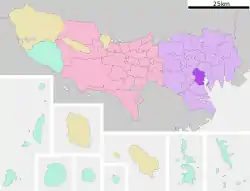Azabu-Jūban
Azabu-jūban (麻布十番) is a district of Minato, Tokyo, Japan. It consists of 1 to 3-chōme. Azabu-Jūban Station is located in this district.

Azabu-Juban is a residential area in central Tokyo with a mixture of Japanese shops, restaurants and bars. The convenience of several supermarkets in a central location and the proximity of Hiroo and Roppongi make it one of the most trendy and sought after residential areas of Tokyo. The main street, a block away from a busy road junction, has a village-like feel with cobbled stoned paving in some places. This atmosphere is created by the narrow streets, slow moving traffic, and a mixture of stores operated by older owners. Even the McDonald's has been carefully designed to be architecturally sympathetic.
Azabu-Juban matsuri
In the middle of August (usually at the beginning or end of the Japanese Obon holiday), Azabu-Juban holds one of the most famous local summer festivals (matsuri) in Tokyo; The event takes place over two days on Saturday and Sunday with the streets being lined with local stalls and food vendors. Traffic is typically blocked from 3:00 to 9:00 pm on both days. During this time, large crowds of festival goers make the main streets largely impassable.
In 2011, this festival was cancelled, due to the practice of jishuku (自粛) - voluntary self-restraint - implemented after the 2011 Tōhoku earthquake.
Azabu-Juban hot spring
Until 2008, Azabu-juban had one of several natural onsen(ja:麻布十番温泉) in Tokyo. Every Sunday from 3:00 pm visitors could enjoy traditional Japanese songs (enka) and dancing. The site of the hot spring has since become a car park.
In fiction
The protagonists of the manga and anime series Sailor Moon reside in this district.[1][2]
References
- Patrick Drazen (1 April 2014). Anime Explosion!: The What? Why? and Wow! of Japanese Animation, Revised and Updated Edition. Stone Bridge Press. p. 279. ISBN 978-1-61172-013-6.
- Jolyon Baraka Thomas (2012). Drawing on Tradition: Manga, Anime, and Religion in Contemporary Japan. University of Hawaiʻi Press. p. 31. ISBN 978-0-8248-3654-2.
